CAA News Today
CWA Picks for October 2017
posted by CAA — October 05, 2017
Each month, CAA’s Committee on Women in the Arts selects the best in feminist art and scholarship.
Her Paris: Women Artists in the Age of Impressionism

Tatiana Parcero, Cartografia Interior #43 , 1996. Lambda print and acetate. 43 x 31 in. Scripps College. Photo credit: jdc Fine Art.
October 22, 2017–January 14, 2018
Denver Art Museum
100 W 14th Avenue Pkwy
Denver, CO
Her Paris: Women Artists in the Age of Impressionism features works created by women in Paris from 1850 to 1900, including well-known artists Berthe Morisot, Mary Cassatt, and Rosa Bonheur, to lesser-known painters such as Anna Ancher and Paula Modersohn-Becker.
At a time of great cultural change, women were barred from attending the Ecole des Beaux-Arts, and it was socially unacceptable for a woman to be unaccompanied in public spaces. The exhibition at the Denver Art Museum traces “how, despite societal challenges women embraced their artistic aspirations and helped create an alternative system that included attending private academies, exhibiting independently, and forming their own organizations, such as the influential Union des Femmes Peintres et Sculpteurs.”
Her Paris is organized by the American Federation of Arts, curated by Laurence Madeline, independent curator and formerly chief curator of Fine Arts at the Musée d’art et d’histoire in Geneva, and curated locally by Angelica Daneo, curator of painting and sculpture at the DAM. Following its run at the DAM, it will travel to The Speed Art Museum in Louisville, Kentucky (February 17–May 13, 2018), and to its final destination at the Clark Art Institute in Williamstown, Massachusetts (June 6–September 3, 2018).
Sobey Art Award Exhibition
October 24–December 9, 2017
Art Museum at the University of Toronto
University of Toronto Art Center
15 King’s College Circle
Toronto, Ontario
The winner and four finalists for the prestigious Sobey Art Award will be on exhibit at the Art Museum at the University of Toronto from October 9 through December 9, 2017. The 2017 finalists for the award, promoting Canadian contemporary art, are Ursula Johnson, Jacynthe Carrier, Bridget Moser, Divya Mehra, and Raymond Boisjoky. The shortlisted artists question and challenge preconceived notions of diversity and identity and performance.
Installation and performance artist Ursula Johnson, of Mi’kmaw First Nation ancestry, often deploys a collaborative process in her place-based performances. “At this time when Canadians are celebrating and challenging the memory of nationhood, Johnson’s work embodies a considered, critical, yet generous lens through which multiple histories and communities may be considered,” juror Sarah Filmore writes.
Finalist Jacynthe Carrier uses photography and video to explore “the different relationships the body has with the environment and ways of conceptualizing and appropriating the land.” Bodies and objects are assembled as intervention in the landscape.
Bridget Moser, selected for the William and Meredith Saunderson Prize for Emerging Artists, hits “all the bewildering emotional registers of internet culture,” writes juror Sarah Robayo Sheridan. “Moser’s singular voice joins a sentinel species of millennial artists alerting audiences to the new paradoxes of commodity culture gone wild, and offers tragicomic remedy in excess of even the most bombastic late night infomercial.”
“Divya Mehra’s work is an astute example of how art can destabilize our collective and individual perceptions about race and gender,” Jenifer Paparo writes. Mehra explores diasporic identities, racialization, otherness and the construct of ‘diversity’ through a variety of mediums, addressing the effects of colonization and institutional racism re-contextualizing references found in hip hop, literature and current affairs.
The fifth finalist, Indigenous artist of Haida descent, Raymond Boisjoly’s practice “concerns the deployment of images, objects and materials, in and as, Indigenous art, using a reflexive approach to foreground the discourses that frame and delimit the work produced by Indigenous artists.” Boisjoly works in various media, from photography to installation, murals and video.
Revolution and Ritual: The Photographs of Sara Castrejón, Graciela Iturbide, and Tatiana Parcero
August 26, 2017–January 7, 2018
Scripps College
Ruth Chandler Williamson Gallery
251 E. Eleventh Street
Claremont, CA
Celebrating three Mexican woman photographers, Revolution and Ritual features work by Sarah Castrejón, Graciela Iturbide, and Tatiana Pacero. Through the work of the three women, the exhibit explores notions of Mexican identity and considers how photography has been transformed over the past century in Mexico and “responds to the artists’ interest in representing present and past, self and other.”
From documentary photography to more poetic photography, the women in the exhibition explore themes of war, indigenous culture, body and self. Castrejón’s images portray people under the intense pressure of war during the Mexican revolution, while Iturbide’s images reflect the daily life of Mexican Indigenous cultures, and Pacero places herself within the frame through self portraits that “incorporate spliced images of her body with cosmological maps and Aztec codices.
The exhibit is accompanied by a catalog with essays Latin American photography scholars John Mraz, Marta Dahó, and Esther Gabara. Revolution and Ritual is a part of Pacific Standard Time: LA/LA, exploring Latin American and Latino art in dialogue with Los Angeles.
Roots of “The Dinner Party”: History in the Making
October 20, 2017–March 4, 2018
Brooklyn Museum of Art
200 Eastern Parkway
Brooklyn, NY
Judy Chicago’s Dinner Party has been a touchstone for feminist thinking about representation, research, and the politics of identity in art history (and history, broadly conceived). Ten years ago the Elizabeth A Sackler Center for Feminist Art opened in the Brooklyn Museum; a triangular gallery, its centerpiece was, and remains, The Dinner Party. This has no doubt been a challenge for the Center’s curator, Catherine Morris—to know that any exhibition will alaways be read in dialogue with Chicago’s monumental work. Yet for an exhibition like this, the gallery’s organization is a boon. This exhibition plumbs Chicago’s process and the processes of her collaborators. Test plates, notebooks, preperatory drawings, and research documents that will be on display attest to the staggering amount of research and prototyping that went into creating The Dinner Party, a work that does its political work– visiblizing women’s contributions to art, science, myth, and all the rest.
Roots of “The Dinner Party”: History in the Making is part of A Year of Yes: Reimagining Feminism at the Brooklyn Museum, a yearlong series of exhibitions celebrating the 10th anniversary of the Elizabeth A. Sackler Center for Feminist Art.
Laura Aguilar: Show and Tell
September 16, 2017–February 10, 2018
Vincent Price Art Museum
1301 Avenida Cesar Chavez
Los Angeles, CA
This exhibition provides the first opportunity to view a diverse sampling from photographer Laura Aguilar’s complex and rich oeuvre. Raised in the San Gabriel Valley, where her family traces its roots back generations, Aguilar was dogged in using her camera to render herself and her various communities visible. You see this in the touching portraits of the women who populated the Plush Pony, a working-class Chicana/Latina lesbian bar. Or in the series “Latina Lesbians” series, wherein Aguilar’s subjects have added their own handwritten words to their portraits. Throughout the show one can follow the various ways Aguilar deploys her own body in her photographs—as bounded to national and ethnic lines of identification, as the repository for the unruly affects of depression, as something solid like a boulder. In one self portrait Aguilar stand between two small table-top displays of toys and catholic ephemera. A Pee-Wee Herman doll shares space with the Virgen de Guadalupe. These heterogenous objects, bespeaking both spirituality and pop culture, are emblematic of just a couple of the many thematics that can be drawn out from this remarkable retrospective.
The exhibition is accompanied by a catalog that is equally impressive, containing essays by: Mei Valenzuela, Christopher A. Velasco, Deborah Cullen, Amelia Jones, James Estrella, Tracy M. Zuniga, Stefanie Snider, Macarena Gómez-Barris, and Sybil Venegas, the curator of Laura Aguilar: Show and Tell and Aguilar’s former mentor.
September 2017 Picks from CAA’s Committee on Women in the Arts
posted by CAA — September 18, 2017
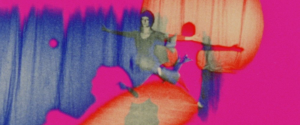
Making/Breaking the Binary: Women, Art, & Technology 1968-1985
October 8-December 8, 2017
Exhibition:
Rosenwald-Wolf Gallery, University of the Arts
333 S Broad St.
Philadelphia, PA
Screening:
Lightbox Film Center at International House Philadelphia
September 28th, October 5th, and October 12th at 7pm
3701 Chestnut St.
Philadelphia, PA
Making/Breaking the Binary: Women, Art, & Technology 1968-1985, is a multi-venue survey focusing on a generation of pioneering female new media artists, reconsidering their role as technology innovators.
Curated by Kelsey Halliday Johnson and initially supported by a $60,000 grant from the Pew Center for Arts & Heritage, the exhibition engages with early computer art, painting, video art, experimental photography, copy machine art, electronic music, and publication projects, among other disciplines.
The exhibition will include visual artists such as Jennifer Bartlett and Lynda Benglis, and video and media art pioneers Sonia Landy Sheridan, Joan Jonas, Lynda Benglis, Shigeko Kubota, and Dara Birnbaum. To accompany the exhibition, Johnson will create a reading library that will place these artists into direct dialogue with a broader history of women in technology, with the aim to “further the scholarship of technology and art surveys in which women are under-represented or not contextualized in the field of their peers,” Johnson says. Featured technologists include Ada Lovelace, the first computer programmer; Katherine Johnson, NASA’s “human computer;” Mary Allen Wilkes, inventor of the operating system; and Rebecca Allen, the first Emmy Award-winning computer animation artist; among others.
The core of the exhibition will be held at the Rosenwald-Wolf Gallery, with auxiliary screenings at Lightbox Film Center and Vox Populi. The opening reception is October 8, 2017, from 4–7pm at Rosenwald-Wolf Gallery.
Tom Thomson & Joyce Wieland : Passion Over Reason
July 1–November 19, 2017
McMichael Canadian Art Collection
10365 Islington Ave
Kleinburg, Ontario
In Passion Over Reason, curator Sarah Stanners brings together work by Tom Thomson and Joyce Weiland and takes a critical approach to Canada’s fascination with Thomson, his status as a cult figure of masculine mystique, and the mystery and mythology of his life story that has cast a virile, woodsy painter as the embodiment of quiet, Canadian resilience.
Interwoven with the work by Thomson, Wieland, whose playful use of sex and humour addresses issues of ecology, patriotism and the pitfalls of nationalism, celebrates a feminist perspective on Canada through her films, collage, and embroidery.
“Wieland’s deep fascination and love for Thomson and for Canada is revealed through the bookwork published alongside her 1971 True Patriot Love exhibition at the National Gallery of Canada (its first solo exhibition for a living Canadian woman artist). In it, Wieland effectively subsumed a government-issued compendium of arctic flora by infiltrating it with needlework, annotations, and photos taken by Tom Thomson.”
With a focus on a play with nationality, gender and sexuality, Passion Over Reason will present a new perspective on two iconic, trailblazing Canadian artists.
Lisa and Janelle Iglesias: Re:Sisters
July 8–October 21, 2017
Arizona State University Art Museum
51 E. 10th St.
Tempe, Arizona
Lisa and Janelle Iglesias, known as Las Hermanas Iglesias, present the fruits of their artist residency at the ASU Art Museum through a new collaborative body of work, Re:Sisters.
Using sculpture, prints and site-specific interventions the sisters focus on both collaboration and resistance and “create artworks that disrupt borders, engage absurdity and promote the benefits of working together. As the title suggests, the works in the exhibition engage the artists’ own familial relationship, resist categorization and speak to processes and gestures of disobedience.
The ASU Art Museum Artist Residency, established in 2011, encourages emerging and established artists to develop and experiment with new bodies of work. Artists selected for the residency have a multi-disciplinary practice with a strong record of process-based, community and collaborative projects in order to explore forms of engagement and to develop socially-based, laboratory-type art projects.
Radical Women: Latin American Art, 1960-1985
September 15–December 15, 2017
Hammer Museum
10899 Wilshire Blvd.
Los Angeles, CA
Boasting a roster of over one hundred artists from fourteen Latin American countries (including the United States), Radical Women: Latin American Art, 1960-1985 demonstrates the rich artistic practices located in, and in dialogue, with Latin America. Radical Women’s co-curators, Cecilia Fajardo-Hill and Andrea Giunta, have put together a path-breaking exhibition, one which promiscuously pursues . Of course, well-known figures are represented here (Marisol, Marta Minujín, Ana Mendieta, etc.), but many artists will be new to a U.S. viewing public. Importantly, the curators decided to include Chicana and Latina artists in their roster, making an important argument regarding the (in)visibility of these artists within U.S.-based art histories as well.
In the catalog, which is an indispensible volume for both scholars of Latin America and neophytes, the co-curators list hundreds of interlocutors and collaborators—each entrenched in the visual and political histories of their respective regions. The exhibition’s strength is predicated on this highly inclusive, collaborative ethos, and will also be a model in terms of how it troubles curatorial authorship and expertise.
Throughout the three-month run of the exhibition local artists, art historians, and curators will be giving walk-through tours of the show, illuminating threads and lines of thought that might otherwise go unnoticed. October 7th brings a concert of contemporary musicians reimagining the music of Peruvian American singer Yma Sumac (née Zoila Augusta Emperatriz Chávarri del Castillo). The exhibition travels to the Brooklyn Museum of Art after it closes in Los Angeles.
Cassils: Monumental
September 16–October 28, 2017
Ronald Feldman Fine Arts
31 Mercer Street
New York, NY
The centerpiece of this exhibition is likely to become the focal point of a flurry of think-pieces come mid-September. That’s because Cassils, who is well-known for their work highlighting and extending the themes of bodily endurance in performance, has been collecting nearly 200 gallons of their own urine since Donald Trump rescinded an Obama-era executive order allowing transgender students to use whichever restroom matches their chosen gender identity. Part protest, part quantifying gesture, Cassil’s pee will be gathered in a new cubic sculpture entitled PISSED—think Hans Haacke’s Condensation Cube (1963-65) but filled with slowly circulating urine. Accompanying this sculpture will be other works that focus on embodied breath, the trans body, and the conditions of duress and memory. Together, these works have much to say to the current administration whose callous disregard of the poor, of people of color, and of queer people (LGBTQIA). If we are living through another culture war—and indeed it seems we are—Cassils has drawn sharp and useful battle lines.
Cassils will present a live performance, Fountain, at the opening reception on September 16, 6-8pm, wherein they will be cathetered to PISSED, evincing the ways in which the trans body is almost always a medicalized body—ammended and abutted by systems of care, treatment, and pathology.
Melike Kara: Köpek
September 7–November 3, 2017
Peres Projects
Karl-Marx-Allee 82
Berlin, Germany
Melike Kara’s paintings represent the latest permutation of the figural group painting genre. Her cast of characters, rendered abstractly and with ambiguous gender and racial characteristics, play, eat, sleep, and have sex. Oftentimes large tongues loll out of their mask-like faces, looking more like diminutive speech balloons than anything else. Throughout these works you can see that Kara is attempting a re-visioning of Modernist painting, a bastardization of Matisse’s arabesque line and color with the more contemporary figural groupings by painters such as Sue Williams, Leon Golub, and Chris Ofili. Recently Kara has begun to play with spatializing her paintings, putting them on glass and using them as room dividers. What this show will bring is a mystery, but given Kara’s bombastic, if short, track record, it will no doubt provide grist for the art historical mill.
August 2017 Picks from CAA’s Committee on Women in the Arts
posted by CAA — August 01, 2017
Hương Ngô: To Name It is to See It
Firelei Báez: Vessels of Genealogies
DePaul Art Museum
935 W Fullerton, Chicago, IL
April 27–August 6, 2017
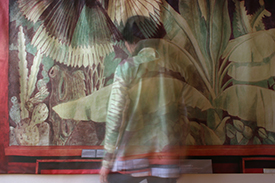
Hương Ngô, study for the video Hidden from Plain Sight, 2017 (artwork © Hương Ngô)
In concurrent exhibitions, the DePaul Art Museum presents Firelei Báez, Vessels of Genealogies, and Hương Ngô, To Name It is to See It. Báez, a Miami-based Dominican-American artist, is known for her use of textiles, patterns, and bright colors. She often depicts identity through the use of hairstyles and tattoos in her large-scale paintings, evoking both beauty and political implications “for those whose cultural identities have remained traditionally absent from dominant culture.” While Báez migrated to the United States, her work also addresses identity formation experienced by those who grew up in Latin, Caribbean, and African regions. She “challenges the basic idea of how race is experienced in the US—a condition defined as binary and black or white. In her work, one can appreciate that she is many cultures. She expresses the consciousness of a new generation eager to embrace their cultural prowess in terms of hybridity.”
In To Name It is to See It, Ngô, focuses on Vietnamese anticolonial organizer Nguyễn Thị Minh Khai. Ngô draws connections between language and seeing. The artist said, “‘To Name It Is To See It’ evokes the promise of a discursive practice, identifying an injustice by name is the first step to understanding it and working towards change. At the same time, there is deception to the title because identification was a preoccupation of the colonial authorities….” The exhibition by Ngô features more than twenty-five individual pieces of art ranging from photos to video and fabrics.
SaveArtSpace: The Future is Female
Through Summer 2017
Various locations throughout New York City
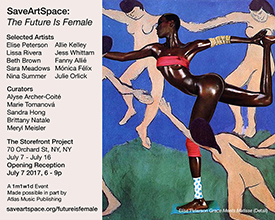 In this all-woman gallery and public art exhibition, The Future Is Female by SaveArtSpact features female artists on advertising spaces and billboards throughout the New York City area during summer 2017. The exhibit aims to expand upon the mainstream definition of “the female gaze” through works that reflect the multifaceted reality of womanhood in the twenty-first century and that expand upon society’s traditional ideals of femininity.
In this all-woman gallery and public art exhibition, The Future Is Female by SaveArtSpact features female artists on advertising spaces and billboards throughout the New York City area during summer 2017. The exhibit aims to expand upon the mainstream definition of “the female gaze” through works that reflect the multifaceted reality of womanhood in the twenty-first century and that expand upon society’s traditional ideals of femininity.
“One such woman is artist Elise Peterson,” writes Priscilla Frank in a HuffPost review, “whose piece Grace Meets Matisse injects a photographic image of Grace Jones into Henri Matisse’s 1910 Dance, placing her in the center of a ring of naked dancers. The image puts Jones’ black body into an image previously filled with white bodies, juxtaposing the flesh of the painted figures with the three-dimensional glow of Jones’ self-actualized body, mid-performance.” (http://www.huffingtonpost.com/entry/feminist-art-new-york-billboards_us_594abba7e4b0312cfb60fb92)
The work was curated by Meryl Meisler, Marie Tomanova, Alyse Archer-Coité, Sandra Hong, and Brittany Natale. In addition to Peterson, artists include Allie Kelley, Beth Brown, Fanny Allié, Jess Whittam, Julie Orlick, Lissa Rivera, Mónica Félix, Nina Summer, and Sara Meadows. Peterson’s work can be viewed in various locations throughout New York City, including Grand Street and Ludlow Street (343 Grand Street).
Jeanine Oleson
Commonwealth & Council
3006 W 7th St. Suite 220, Los Angeles, CA
July 8–August 19, 2017
The amplification of sound and image is at the center of Jeanine Oleson’s powerful exhibition at Commonwealth & Council. Using natural materials such as shell and glass within a performance-based lexicon, Oleson examines the effects of production under late capitalism, the meanings of community, and bodily experience. Three-dimensional imaging technology is employed to render visible what we already see but which we might not value; and elsewhere a transducer speaker made of shell expertly turns an object of childlike wonder into a proxy for political speech. Although not specifically positioned as a pendant to Oleson’s Hammer exhibition, concurrently on view, many of the interests in the two shows are similar, and benefit from a close read. At issue in both is how one might become a conductor—realizing the longing for a political elsewhere—using materials of the body and the world?
CUNT
Venus Over Los Angeles
601 S Anderson St, Los Angeles, CA
July 15–September 2
Although more iconographic than strictly historical, this group exhibition brings together six feminist artists who address the visuality of female bodies and their attendant sexualities. Betty Thompkins, Carolee Schneemann, VALIE EXPORT, Judith Bernstein, Dorothy Iannone, and Marilyn Minter may each depict the vulvic, but their similarities end there. Iannone’s confessional work, I Was Thinking of You (1975/2006), displays a video of artist’s face while she masturbates, housed in a lovingly decorated cabinet which recounts an old story of love and abuse (the text on the cabinet’s exterior begins: “You walk into my quarters 2000 years ago which are outside the city gates….”) The exhibition features new work by some of the artists—most notably a large black-light mural by Bernstein, in which a giant limp phallus covered in swastikas comes to stand for the “Trumpery” of America’s current political hierarchy. Nearby, a vagina dentata seems to be growing out of the official seal of the United States. It is a caustic and damning work—one filled with heaps of rage and anger—revealing why explicitness in our lives, politics, and art are as necessary as ever.
As in Nature: Helen Frankenthaler Paintings
225 South Street
Williamstown, MA 01267
July 1–October 9, 2017
As in Nature: Helen Frankenthaler Paintings presents twelve of this major Abstract Expressionist artist’s large-scale paintings. Made over the course of her long career, these works explore the tension between abstraction and representation and demonstrate her engagement with the landscape painting tradition. In particular, she found inspiration in the idyllic, wooded landscapes of the northeastern United States, home of the Clark Art Institute. Spanning the full range of styles, techniques, and formal preoccupations that Frankenthaler explored over five decades of work, these paintings are primarily abstract, yet reveal recognizable elements from the landscape that function, paradoxically, to reinforce their abstraction: as in nature, but not as in nature. As she said of one of her most iconic paintings, Mountain and Sea (1952), “The landscapes were in my arms as I did it. I didn’t realize all that I was doing. I was trying to get at something—I didn’t know what until it was manifest.”
A publication, authored by guest curator Alexandra Schwartz, with contributions by Christina Kee, accompanies this exhibition.
Marina Abramović: The Cleaner
Gammel Strandvej 13
DK 3050 Humlebaek, Denmark, Copenhagen
June 17–October 22, 2017
This summer, the Louisiana Museum of Art presents Marina Abramović: The Cleaner, the first major European retrospective presentation of this pioneering body and performance artist. The exhibition at Louisiana comprises more than one hundred works and spans more than five decades—from early concept sketches, paintings, and sound works to presentations of the artist’s performances—including her collaboration with former partner Ulay. Reperformances of an early work form part of the exhibition as well. The exhibition is structured chronologically, beginning with her Sound Corridor (War) of 1971, where the spectator is inundated with the sounds of gunfire, and ending with her quieter and more transformative works.
Marina Abramović: The Cleaner has been developed in a dialogue with the artist and is organized by Moderna Museet, Stockholm, in collaboration with the Louisiana Museum of Modern Art, Henie Onstad Kunstsenter, and Bundeskunsthalle, Bonn.
CWA Picks for July 2017
posted by CAA — July 03, 2017
Each month, CAA’s Committee on Women in the Arts selects the best in feminist art and scholarship. The following exhibitions and events should not be missed.
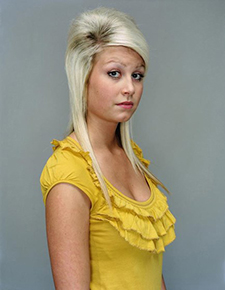
Rineke Dijkstra, Amy, The Krazy House, Liverpool, December 23, 2008, 2008 (collection of the artist)
Rineke Dijkstra: An Ode
Stedelijk Museum
Museumplein 10, 1071 DJ, Amsterdam, Netherlands
May 20–August 6, 2017
In celebration of Rineke Dijkstra’s recent honor of receiving the prestigious Hasselblad Foundation’s International Award in Photography for 2017, the Stedelijk Museum has mounted a small but excellent curated exhibit of this lauded Dutch artist. Twenty-one photographs and four videos are included in An Ode, which showcases Dijkstra’s masterful technique and remarkable sensitivity to her youthful subjects and the delicate process of their coming of age. As the artist noted, “With young people everything is much more on the surface—all the emotions. When you get older you know how to hide things.” Under her keen eye and deft hand, portraits of adolescence become something intimate and lovely and compelling.
The exhibit, which draws from Stedelijk’s own extensive collection of her work, as well as loans from the artist, is meant to be a celebration as well as an amuse-bouche for later offerings in the season. Later this year, the museum will present Dijkstra’s work Almerisa (1994–2008), a series of portraits that follows the life of a young Bosnian refugee girl from her arrival in the Netherlands to her adulthood.
Acolytes of this contemporary photographer can also see an extensive retrospective of her work at the Louisiana Museum (Copenhagen, Denmark) this fall, and then at the Museum de Pont (Tilberg, the Netherlands) in early 2018.
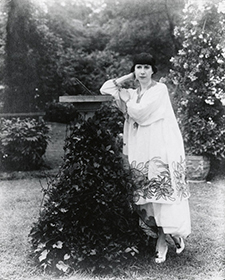
Florine Stettheimer, photograph by Peter A. Juley & Son, ca. 1917–20 (image provided by Peter A. Juley & Son Collection, Photograph Archives, Smithsonian American Art Museum, Washington, DC)
Fahrelnissa Zeid
Tate Modern
Bankside, London SE1 9TG
June 13–October 8, 2017
In the first major retrospective of her work, the Turkish artist Fahrelnissa Zeid, a pioneer in the European avant-garde of the 1940s and 1950s, dazzles. Trained in Paris and Istanbul (one of the first women to go to art school there), she produced work that synthesized historical and contemporary Middle Eastern and European artistic practices. Zeid, a princess and Muslim, cut an unusual figure in the midcentury art world. Her oeuvre is astonishingly diverse, ranging from large abstract paintings to smaller figurative pieces, and from traditional materials to new media such as chicken bones, which she painted, cast into polyester resin, and fashioned into stained-glass-like objects.
Zeid’s vibrant and energetic works were widely exhibited and enjoyed critical success, and yet her work fell into obscurity in subsequent decades. Frances Morris, the director of Tate Modern, told the Guardian of the rediscovery of her work on a 2008 trip to Istanbul, saying: “We were stunned to encounter for the first time in our lives, these huge, ornate, decorative, multifaceted, brilliantly coloured, swirling abstract paintings. We’d never seen her work in our lives and we’d never seen anything like it. It was a really exciting moment.” The retrospective of Fahrelnissa Zeid is part of the museum’s stated commitment to showcase artists of the modern era who have been overlooked and underrepresented in the art world.
Florine Stettheimer: Painting Poetry
Jewish Museum
1109 5th Ave, New York, New York
May 5–September 24, 2017
Writing for Art in America in 1980, the art historian Linda Nochlin made this assessment of Florine Stettheimer’s work: “Florine Stettheimer, the artist, existed in this world, it is true, but still somewhat apart from it––as her painting exists apart from the major currents of her time.” Stettheimer, who was born in Rochester and studied at the Art Student League of New York, is known for her affected paintings (sometimes with accompanying sculptural, scalloped frames), that reflect the comings and goings of her family—most notably her two other sisters—and a host of artists, writers, and other members of New York’s intelligentsia. Marcel Duchamp was a friend, and she was a frequent theater-goer, even designing the sets and costumes for the 1934 production of Gertrude Stein’s opera intended for an all-black cast, Four Saints in Three Acts. Oh, and she wrote poetry, which is a constant presence throughout this exhibition at the Jewish Museum. Reading her poetry, like looking at some of her works, can sometimes feel like an exhausting account of the pleasures of being one of the “haves”: “My attitude is one of Love / is all adoration / for all the fringes / all the color / all tinsel creation / I like slippers gold / I like oysters cold / and my garden of mixed flowers / and the sky full of towers / and traffic in the streets / and Maillard’s sweets / and Bendel’s clothes / and Nat Lewis hose / and Tappé’s window arrays / and crystal fixtures / and my pictures / and Walt Disney cartoons / and colored balloons.” Still, there’s a soulful seeing behind her spindly figures, especially her self-portraits and portraits of her closest family members. Taken together these paintings are a masterclass in forging an artistic path of one’s own.
Star Montana: I Dream of Los Angeles
Beta Main
114 W. 4th St., Los Angeles, CA
May 7–July 23, 2017
Star Montana’s photographs line the walls of the Main Museum’s Beta space—each a portrait of someone who the artist encountered on the streets or met through an open call. Some are friends. Most are strangers. Yet all are given a kind of monumental attention in Montana’s practice. Alongside each photograph is a small piece of writing, reflecting on the circumstances in which the picture was taken, the first time Montana met her subject, or a meditation on the vagaries of dailyness living in East and South Los Angeles. The viewer scans between words and picture, looking for the same vulnerabilities and strengths in the images that appear in the text. The colors of these photographs are lush, and the relationship between sitter and photographer is palpable, close. It is an ode to this great and complex city, as evinced through the people who live in it.
Gray Matters
Wexner Center for the Arts
Ohio State University, 1871 North High Street, Columbus, OH
May 20–July 30, 2017
Now on view at the Wexner Center for the Arts, Gray Matters brings together thirty-seven contemporary women artists exploring the practice of grisaille—the French term for working in shades of gray. “Ranging from emerging to well-established, these artists challenge an all-too-simplistic notion of colorless ‘neutrality’ as they reveal the variegated spectrum of black, white, gray, and everything in between.”
The more than fifty works include a variety of mediums and media, from sculpture to portraiture, video to graphite drawings. Among the works is Mickalene Thomas’s Hair Portrait #20 (2014). Known for her colorful canvasses, Thomas tones down her palette in Hair Portrait #20 “without relinquishing her celebratory use of rhinestones.” Also on view in the exhibition is Bethany Collin’s A Pattern or Practice (2015). In this piece the viewer is confronted with a wall installation of ninety-one blind-embossed portions of the US Department of Justice report on the Ferguson police department. “The show goes incredibly quiet with an idea that is incredibly loud,” Michael Goodson, senior curator of exhibitions, described arriving at the neatly spaced white sheets, with the words of the report pushing up the fibers of the paper.
Other artists in the exhibition include: Tauba Auerbach, Carol Bove, Gisele Camargo, Vija Celmins, Bethany Collins, Marsha Cottrell, Tacita Dean, Tara Donovan, Marlene Dumas, Michelle Grabner, Josephine Halvorson, Mona Hatoum, Roni Horn, Cristina Iglesias, Jennie C. Jones, Toba Khedoori, Laura Lisbon, Suzanne McClelland, Julie Mehretu, Katie Paterson, Joyce Pensato, Amalia Pica, Mary Reid Kelley, Michal Rovner, Nancy Rubins, Arlene Shechet, Erin Shirreff, Amy Sillman, Xaviera Simmons, Diane Simpson, Lorna Simpson, Avery Singer, Michelle Stuart, Mickalene Thomas, Kara Walker, Rachel Whiteread, and Carmen Winant.
A video of the exhibit, behind the scenes with artists’ interviews, can be found on YouTube here: https://www.youtube.com/watch?v=KIcdKkJV3Mg.
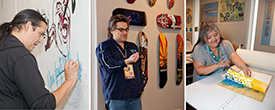
Melanie Yazzie, Gregg Deal, and Walt Pourier
Melanie Yazzie, Gregg Deal, Walt Pourier: Action X Community X Togetherness
Denver Art Museum
100 W 14th Avenue Pkwy, Denver, CO
May 6–September 7, 2017
Alumni of the Native Arts Artists-in-Residence program at the Denver Art Museum return for a summer of collaboration and creation. Melanie Yazzie, Gregg Deal, and Walt Pourier are cocreating through a project titled Action X Community X Togehterness X.
The Native Arts Artists-in-Residence program kicked off in 2012 with Yazzie and has gone on to host many established and up-and-coming artists working across media. Yazzie, a sculptor, painter, printmaker, and installation artist, often collaborates with indigenous artists, including those from groups in New Zealand, Siberia, Australia, and Canada, among others. Her work is informed and shaped by personal experiences and tries to tell many stories about things both real and imagined. It follows the Diné dictum “walk in beauty” literally, creating beauty and harmony.
“My artwork is culturally based in my heritage of being a Diné (Navajo) person. The artworks stem from the thought and belief that what we create must have beauty and harmony from within ourselves, from above, below, in front, behind and from our core. We are taught to seek out beauty and create it with our thoughts and prayers. I feel that when I am making my art, be it a print, a painting or a sculpture, I begin by centering myself and thinking it all out in a ‘good way,’ which is how I was taught from an early age. My work speaks about travel and transformation.”
In the joint projects Yazzi, Deal, and Pourier will host talks, tours, and workshops at two Untitled Final Fridays, on July 28, and August 25. They will hold a hands-on artmaking workshop at the Friendship Powow and American Indian Cultural Celebration on September 9 also.
CWA Picks for June 2017
posted by CAA — June 09, 2017
Each month, CAA’s Committee on Women in the Arts selects the best in feminist art and scholarship. The following exhibitions and events should not be missed.
Julia Jacquette: Unrequited and Acts of Play; Playground of My Mind
Ruth and Elmer Wellin Museum of Art
Hamilton College, 198 College Hill Road, Clinton, NY
February 18–July 2, 2017
In her first major museum retrospective, artist Julia Jacquette unveils two exhibitions, Unrequited and Acts of Play and Playground of My Mind, at the Wellin Museum of Art in Clinton, New York. Curated by Tracy L. Adler, the Johnson-Pote Director of the Wellen Museum, Unrequited focuses on commercialized objects of desire, “exposing our seemingly insatiable longing for the ideal.” Known for taking her inspiration from cookbooks and contemporary food magazines, Jacquette presents “these material trappings … often close up, in crisply detailed paintings that both profess and resent such desires and the complications they present personally, socially, and culturally.”
“I feel the gender of food is an under discussed topic. The kind of food images I use are a kind of highly styled food, that I think was and is targeted at women—food that looks like it is achieving a kind of domestic perfection,” Jaquette said in an interview with Maxwell Williams.
Running simultaneously, Playground of My Mind is a graphic memoir based on the “adventure playgrounds” of New York City and Amsterdam during the 1970s. “These structures encouraged constructive, imaginative play and gave renewed life to utopian notions of American and European modernist architecture.” Jacquette’s father codesigned one for Central Park. The body of work, comprised of gouache drawings and an illustrated artist book, explores their influence on Jaquette’s aesthetic.
The exhibit also includes space for community-organized, play-oriented projects based on the project. A schedule is available online.
Michelle Vosper: Creating Across Cultures: Women in the Arts from China, Hong Kong, Macau and Taiwan
Book
ISBN9789881604705
Released February 2017 by Muse Press
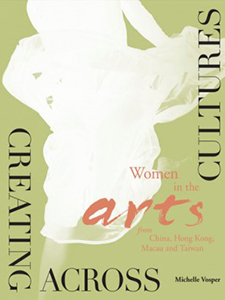
Creating Across Cultures: Women in the Arts from China, Hong Kong, Macau and Taiwan presents essays by journalists, scholars, and artists celebrate the artistic achievements of sixteen visionary women. Edited by Michelle Vosper, formerly the Asian Cultural Council Representative, the 360-page, hardback book profiles contemporary artists such as Yin Xiuzhen 尹秀珍, visual artist, and Lulu Hou 侯淑姿, photographic artist.
“These courageous women often had to defy cultural expectations in order to heed their artistic drive. Their artworks delve into the social realities of their times, and their personal stories provide an intimate portrait of the historical trajectory of Greater China over three generations.”
Other artists profiled include Nieh Hualing 聶華苓, author; Liao Wen 廖雯, art critic and curator; Candace Chong 莊梅岩, playwright; Choi Yan Chi 蔡仞姿 , artist and educator; Jaffa Lam 林嵐, installation artist; Yang Lina 楊荔鈉, filmmaker; Bun-Ching Lam 林品晶, composer; Wang Xinxin 王心心, Nanguan performer; Tian Mansha 田蔓莎, Sichuan Opera performer; Wu Na 巫娜, guqin musician; Yang Meiqi 楊美琦, modern dance pioneer; Pisui Ciyo 碧斯蔚 .梓佑, dancer/choreographer/vocalist; Mui Cheuk Yin 梅卓燕, dancer/choreographer; and Wen Hui 文慧, dancer/choreographer.
The essay authors include Liza Bielby, Christina Yuen Zi Chung, Samantha Culp, Valerie C. Doran, Jennifer Feeley, Georg Kochi, Tina Li Ying Ma, Terry O’Reilly, Ralph Samuelson, Clare Tyrrell-Morin, and Sasha Su-Ling Welland.
Octavia E. Butler: Telling My Stories
Huntington Library, Art Collections, and Botanical Gardens
1151 Oxford Road, San Marino, CA
April 8–August 7, 2017
Last year, Julia Meltzer (curator and director of the Clockshop) invited twelve artists and writers to mine the archives of Pasadena-based sci-fi writer Octavia E. Butler, who had passed away some ten years before. Because Butler gave her archive to the Huntington, much of the research for the new works and writings occasioned by Meltzer’s show happened in the Huntington’s library. Entitled Radio Imagination, that exhibition was a meditation on some of the key themes in Butler’s works (disenfranchisement, survival, the power of the mind) as well as the tricky business of re-presenting stories, documents, and a life that remains under recognized.
Now the Huntington has entered the fray with their own exhibition, this one tightly focused on the contents of Butler’s archives. It includes some of the early writings (and a really wonderful drawing of two horses) the author composed while still a child, as well as drafts of books and stories. Butler had a habit of color coding her documents, making notes with brightly colored highlighters—so these pieces of paper often have a striking visual quality. But it is the words, the prose, and the bare-bones reflections of an author working arduously to always do better that are really the stars here. In a letter sent to her mother from a pit of despair while at (what would be the first of many visits to) the Clarion Science Fiction and Fantasy Writer’s Workshop, Butler beats herself up for being blocked, and for not getting more accomplished. For a writer who was fairly private while she lived, these documents can be a revelation regarding the vulnerabilities of process, the messiness of affect, and the rigor of a brilliant mind and storyteller.
Pia Camil: Bara Bara Bara
Dallas Contemporary
161 Glass Street, Dallas, TX
April 8–August 20, 2017
“Bara! Bara! Bara!” is the cry that vendedores make in the markets in Itzapalapa, one of the sixteen boroughs of Mexico City, to lure in buyers with the promise of cheap (“barato”) goods. For her solo exhibition at the Dallas Contemporary, Mexico-based artist Pia Camil transforms some of the most ubiquitous materials from these markets, T-shirts, into expansive fields of color. These shirts are often made in Mexico (and many other countries outside the US), sold to US consumers, and then, after trickling through second-hand stores, they are eventually shipped by the tonnage back to Mexico and Central America, where they are sold to new markets. The global circuit of vestments is well-trod ground in contemporary art, one example being Shinique Smith’s Bale Variants series (2009–14). But Camil’s project is differently expansive, both formally and conceptually.
Suspended from the vast ceiling of the Dallas Contemporary’s warehouselike space, Camil’s t-shirt sheets look like low-hanging clouds, droopy body parts (bellies, breasts, asses), or, in a call-back to the site of acquisition, the informal coverings of outdoor markets. Because each of these works is called Divisor Pirata, they bear some relation to Lygia Pape’s Divisor, first performed in 1967–68. In that performance, participants from the streets of Rio de Janeiro filled in the holes of a large white piece of fabric and then travelled as a communal body through the streets. Indeed, Camil’s sheets are full-up with performance potential: viewers are invited to stick their heads through the neck holes, thus changing their perspective and relationship to these forms. What once operated like a covering now functions as a shifting new ground, rolling and roiling.
We Wanted a Revolution: Black Radical Women, 1965–85
Brooklyn Museum
200 Eastern Parkway, Brooklyn, New York 11238-6052
April 21–September 17, 2017
After almost fifty years after the groundbreaking show of contemporary black women artists, Where We At, the Brooklyn Museum has organized a landmark exhibition to honor and extend the work of these art activists. As its organizers proudly proclaim, We Wanted a Revolution: Black Radical Women, 1965–85 “is the first exhibition to highlight the voices and experiences of women of color—distinct from the primarily white, middle-class mainstream feminist movement—in order to reorient conversations around race, feminism, political action, art production, and art history in this significant historical period.” Featuring a wide array of media—film, performance, conceptual and video art, as well as painting, sculpture, photography, and print media—We Wanted a Revolution captures the energy and vitality of these critical interventions into the art practices of this formative era. Simply put, this exhibition is a must-see.
The artists represented in the exhibition include Emma Amos, Camille Billops, Kay Brown, Vivian E. Browne, Linda Goode Bryant, Beverly Buchanan, Carole Byard, Elizabeth Catlett, Barbara Chase-Riboud, Ayoka Chenzira, Christine Choy and Susan Robeson, Blondell Cummings, Julie Dash, Pat Davis, Jeff Donaldson, Maren Hassinger, Janet Henry, Virginia Jaramillo, Jae Jarrell, Wadsworth Jarrell, Lisa Jones, Loïs Mailou Jones, Barbara Jones-Hogu, Carolyn Lawrence, Samella Lewis, Dindga McCannon, Barbara McCullough, Ana Mendieta, Senga Nengudi, Lorraine O’Grady, Howardena Pindell, Faith Ringgold, Alva Rogers, Alison Saar, Betye Saar, Coreen Simpson, Lorna Simpson, Ming Smith, and Carrie Mae Weems.
The exhibition is accompanied by a sourcebook, edited by Catherine Morris and Rujeko Hockley and published by Duke University Press, which reprints important essays, correspondence, critiques, and manifestoes from key figures in this movement. Authors include Gloria Anzaldúa, James Baldwin, bell hooks, Lucy R. Lippard, Audre Lorde, Toni Morrison, Lowery Stokes Sims, Alice Walker, Michelle Wallace, and others.
Peju Alatise: Flying Girls, Nigerian Pavilion, 57th Venice Biannale
Scoletta dei Battioro e dei Tiraoro
Campo San Stae, 1980 30135, Venice, Italy
May 13–November 26, 2017
In this historic exhibition, the first-ever Nigerian Pavilion at the Venice Biannale, artist Peju Alatise takes the theme “How About NOW?” seriously. Her contribution to the Nigerian pavilion is an installation titled Flying Girls. Made over a three-year period from 2013–16, it is composed of eight black-painted and life-sized figures of girls, standing in a circle, who appear to have sprouted wings. Above them hovers a flock of birds. The work is a clear reference to the ongoing kidnapping and sexual enslavement of the Nigerian girls by Boko Haram. Flying Girls alludes to a character in one of Alatise’s books, a Yoruban girl who has been sold into domestic servitude and who dreams she belongs to no one but herself and can escape her imprisonment through flight.
Alatise, who was trained as an architect and is a renowned poet and novelist as well as a visual artist, is committed to producing works that addresses the social, political, and gender issues facing her country, with particular attention to what womanhood means within these contemporary contexts. She said this of her contribution to the Nigerian Pavilion: “I thought I would give a voice to the most vulnerable, which is the young black girl—especially in Nigeria,” she says. “It’s not necessarily focusing on that label, but the vulnerability of the girl child and the fact we do not have the government, cultural knowledge and aspiration to do something to help the girl child.”
CWA Picks for May 2017
posted by CAA — May 01, 2017
Each month, CAA’s Committee on Women in the Arts selects the best in feminist art and scholarship. The following exhibitions and events should not be missed.
Louise Lawler: A Movie Will Be Shown Without a Picture
Museum of Modern Art
11 W 53 Street, New York, NY
May 2 and 10, 2017
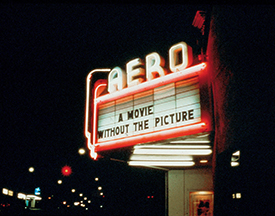
Marquee for A Movie Will Be Shown Without the Picture, Aero Theatre, Santa Monica, California, December 7, 1979 (photograph by Louise Lawler)
An appropriately deadpan announcement, now in the collection of the Metropolitan Museum of Art, for Louise Lawler’s cinematic event A Movie Will Be Shown Without A Picture (1979), reproduced the work’s title on a flat black card. Indeed, this is what viewers to the Aeron Theater in Santa Monica would have encountered on the night of Lawler’s event: a film shown without its flickering image. We might understand Lawler’s gesture as a riposte to Laura Mulvey’s influential text “Visual Pleasure and Narrative Cinema,” published five years before in the British film journal Screen. The filmic performance deprives audiences of the picture of the chosen film (the film changes with each iteration), instead asking them to rely on sound and soundtrack. Thus viewers are left to imagine and project their own fantasies (if they haven’t seen the film) or cobble together their memories of the film (if they have). As an arm of the programming for Louise Lawler’s retrospective at the Museum of Modern Art in New York, A Movie Will Be Shown Without a Picture will be screened two times.
Black Women Artists for Black Lives Matter
Project Row Houses
2521 Holman St., Houston, TX
March 25–June 4, 2017
Usually the curatorial and programming staff at Project Row Houses determine a theme and invite a series of artists to make installations and public programming inside the block of row houses in Houston’s Third Ward. This time Public Art Director Ryan Dennis and artist Simone Leigh cocurated the round to be exclusively for Black Women Artists for Black Lives Matter, a collective group that Leigh founded during her residency at the New Museum last year, and which now has chapters in London, Los Angeles, and Chicago. Performances, installations, platforms for dialogue and activation—these are the things that tie Project Row Houses and Black Women Artists for Black Lives Matter together. What began with an incubation period to get Houston’s chapter of BWA for BLM started, and was inaugurated with a processional performance, is now a full-tilt community platform for building generative ideas and actions for entering into the movement. As if to sum up the sentiments of the current round, one of the row houses is emblazoned with a supergraphic of the following sentiment: “YOU’VE GOTTA LOVE US OR LEAVE US ALONE.”
Katharina Fritsch: Multiples
Walker Art Museum
725 Vineland Place, Minneapolis, Minnesota
May 11–October 15, 2017
Katharina Fritsch’s sculpture, which seeks to defamiliarize the familiar and query the boundaries between the natural and the symbolic, will be on view at the Walker Art Museum for the next several months. Animals, religious figurines, body parts, and other objects drawn from the history and fairy tales of her native Germany take one new meanings when color, scale, and materials of everyday objects are altered. The show will include some forty objects, ranging from her early work as a student to her more recent pieces, drawn from the museum’s permanent collection. Katharina Fritsch: Multiples is a companion exhibition to the installation of her monumental, ultramarine blue Hahn/Cock in the Minneapolis Sculpture Garden in June. Described by the artist as “a feminist sculpture,” this work was first displayed on the fourth plinth in Trafalgar Square in the summer of 2013.
Musée Camille Claudel
Musée Camille Claudel
10, rue Gustave Flaubert, 10 400 Nogent-sur-Seine, France
Opened March 26, 2017
At long last, the beloved nineteenth-century French sculptor and feminist art icon Camille Claudel is receiving her due with a museum devoted to her work. Located in the small town of Nogent-sur-Seine, the Musée Camille Claudel is built around the family home where she spent her early adolescence. After a temporary exhibition of her work in 2003 brought over forty thousand visitors to Nogent-sur-Seine (pop. 6,000), it was determined that a museum dedicated to its most famous resident was in order. The Musée Camille Claudel now houses the world’s largest collection of the sculptor’s work. Visitors, who will be gratified to see such well-known pieces as The Waltz and The Gossips, will also be able to discover similarly remarkable works such as Abandon and Fortune. It takes under an hour by train to reach Nogent-sur-Seine from Paris.
Power: Work by African American Women from the Nineteenth Century to Now
Sprüth Magers
5900 Wilshire Blvd, Los Angeles, CA
March 29–June 10, 2017
The exhibition Power at Sprüth Magers features thirty-seven African American women artists from the nineteenth century until now. Works span fine-art and folk-art traditions covering multiple mediums, including painting, photography, video, sculpture, and installation. The title of the exhibition takes its name from a 1970 gospel song by Sister Gertrude Morgan, a self-taught, musician, poet, artist, and preacher. The works, engaging in issues of race, gender, and class, trace the threads of the craft-based folk traditions to a newer, academically trained generation of artists, depicting the “struggle to establish themselves as equal players on the uneven field of the American republic.”
In a review of the show published in the Los Angeles Times on April 11, 2017, the author Leah Ollman writes, “Artists here treat the physical body and the emblematic body of the nation as contested sites. Historical trauma persists within both, and both serve as ready—if not always willing—vehicles for self-determination.”
Artists in the exhibition, which was curated by Todd Levin, include: Beverly Buchanan, Elizabeth Catlett, Sonya Clark, Renee Cox, Njideka Akunyili Crosby, Karon Davis, Minnie Evans, Nona Faustine, LaToya Ruby Frazier, Ellen Gallagher, Leslie Hewitt, Clementine Hunter, Steffani Jemison, Jennie C. Jones, Simone Leigh, Julie Mehretu, Sister Gertrude Morgan, Senga Nengudi, Lorraine O’Grady, Sondra Perry, Howardena Pindell, Faith Ringgold, Betye Saar, Joyce J. Scott, Emmer Sewell, Ntozake Shange, Xaviera Simmons, Lorna Simpson, Shinique Smith, Renee Stout, Mickalene Thomas, Alma Woodsey Thomas, Rosie Lee Tompkins, Kara Walker, Meta Vaux Warrick Fuller, Carrie Mae Weems, and Brenna Youngblood.
Power will also include an installation of over one hundred African American vernacular photographs from the early twentieth century on loan from the Ralph DeLuca Collection. They offer a diverse view into everyday lives of African American women, from images of positive change to difficult scenes of negative stereotyping and violence. Offered as an exhibition-within-an-exhibition, these images from a century ago encourage reflection upon the continued struggles of black lives in America today.
We Wanted a Revolution: Black Radical Women, 1965–85
Brooklyn Museum
Elizabeth A. Sackler Center for Feminist Art and Stephanie and Tim Ingrassia Gallery of Contemporary Art, Fourth Floor, 200 Eastern Parkway, Brooklyn, New York
April 21–September 17, 2017
The exhibition We Wanted a Revolution: Black Radical Women, 1965–85 explores the intersections of avant-garde art worlds, radical political movements, and profound social change through photography, sculpture, printmaking, photography, performance, film, and video. Examining the political, social, cultural, and aesthetic priorities of women of color during the emergence of second-wave feminism, this exhibition is the first “to highlight the voices and experiences of women of color—distinct from the primarily white, middle-class mainstream feminist movement—in order to reorient conversations around race, feminism, political action, art production, and art history in this significant historical period.”
The artists represented in the exhibition include: Emma Amos, Camille Billops, Kay Brown, Vivian E. Browne, Linda Goode Bryant, Beverly Buchanan, Carole Byard, Elizabeth Catlett, Barbara Chase-Riboud, Ayoka Chenzira, Christine Choy and Susan Robeson, Blondell Cummings, Julie Dash, Pat Davis, Jeff Donaldson, Maren Hassinger, Janet Henry, Virginia Jaramillo, Jae Jarrell, Wadsworth Jarrell, Lisa Jones, Loïs Mailou Jones, Barbara Jones-Hogu, Carolyn Lawrence, Samella Lewis, Dindga McCannon, Barbara McCullough, Ana Mendieta, Senga Nengudi, Lorraine O’Grady, Howardena Pindell, Faith Ringgold, Alva Rogers, Alison Saar, Betye Saar, Coreen Simpson, Lorna Simpson, Ming Smith, and Carrie Mae Weems.
A host of events accompanied the exhibition. In addition to the DJ reception on April 20, which paid tribute to the revolutionary music of black women, the week-long opening celebration also included a symposium on April 21, a Julie Dash film marathon on April 22, and a Black Lunch Table on April 23.
We Wanted a Revolution, organized by Catherine Morris, Sackler Family Senior Curator for the Elizabeth A. Sackler Center for Feminist Art, and Rujeko Hockley, former assistant curator of contemporary art at the Brooklyn Museum, is part of A Year of Yes: Reimagining Feminism at the Brooklyn Museum, a yearlong series of exhibitions celebrating the tenth anniversary of the Elizabeth A. Sackler Center for Feminist Art.
CWA Picks for April 2017
posted by CAA — March 30, 2017
Each month, CAA’s Committee on Women in the Arts selects the best in feminist art and scholarship. The following exhibitions and events should not be missed. Check the archive of CWA Picks at the bottom of the page, as several museum and gallery shows listed in previous months may still be on view or touring.
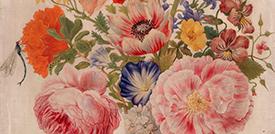
Maria Sibylla Merian, Chinese Vase with Roses, Poppies and Carnations, ca. 1670–1680 (photograph © Staatliche Museen zu Berlin, Kupferstichkabinett / Dietmar Katz)
Maria Sibylla Merian and the Tradition of Flower Illustration
Kupferstichkabinett, Berlin
Matthäikirchplatz, 10785 Berlin, Germany
April 7–July 3, 2017
Städel Museum in Frankfurt
Schaumainkai 63, 60596 Frankfurt am Main, Germany
October 11, 2017–January 14, 2018
Academic conference
University of Amsterdam
ARTIS Library, Plantage Middenlaan 45-45A, 1018 DC Amsterdam, Netherlands
June 7–9, 2017
In commemoration of the three hundredth anniversary of the death of the German-born illustrator and naturalist Maria Sibylla Merian, the Kupferstichkabinett in Berlin (April 7–July 2, 2017) and Städel Museum in Frankfurt (October 11–January 14, 2018) are sponsoring a joint show of approximately 150 of her works on paper and vellum. Known for her exquisite depictions of flowers and insects, Merian had an international reputation in her lifetime. Her illustrated texts include a volume of engravings of flora and fauna she produced while on a scientific expedition to the Dutch colony of Surinam in 1699. As a complement to this exhibition, the University of Amsterdam is sponsoring an academic conference titled “Changing the Nature of Art and Science: Intersections with Maria Sibylla Merian” (June 7–9, 2017), where her contributions to the history of printmaking, natural history, and botanical art will be honored.
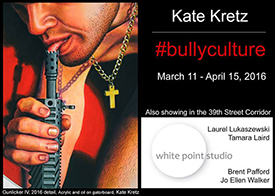
Invitation for Kate Kretz’s #bullyculture
Kate Kretz: #bullyculture
39th Street Gallery and Corridor Exhibition Space
Gateway Arts Center, 3901 Rhode Island Ave, Brentwood, Maryland
March 11–April 15, 2017
#bullyculture represents the first phase of an ambitious in-progress series that Kate Kretz commenced in 2011 and will conclude later this year. In her quest to find the common denominator to all the crimes against women, children, “minorities,” animals, and the earth, she has produced a large corpus of works on paper, sculpture, paintings, textiles, and mixed media. Some of the themes she explores in this series include “trophy hunting, VIP culture and ‘the 1%’, corporate destruction of the earth, rape culture and sexual entitlement, the fetishization of guns and their use for intimidation.” The artist, who has received numerous awards and grants, including the Southeastern College Art Conference’s 2016 award for Outstanding Artistic Achievement and a position on the Fulbright Specialist Roster through 2021, will be giving a lecture on April 1.
Shagha Ariannia: Who Sings the Nation-State?
Vincent Price Art Museum
East Los Angeles College, 1301 Avenida Cesar Chavez, Monterey Park, CA
March 18–June 10, 2017
A little over fifteen years ago, and one week after 9/11, Shagha Ariannia and her family arrived to Los Angeles as migrants from Iran. Ariannia has mined this particularly potent history of travel, place-finding, and identity-in-transit throughout her artistic career by, for example, annotating her family’s photographic archives in a series called What would America/Iran do without Iran/America? (2012). This solo exhibition focuses on a series of works Ariannia has been creating using national anthems from various countries (Iran and the United States included, among many others). In this way she takes seriously the titular question posed by Gayatri Spivak and Judith Butler in their 2007 dialogue Who Sings the Nation-State? As Butler says in that text, in regard to hearing the US national anthem sung in Spanish in the streets of Los Angeles, “The monolingual requirement of the nation surely surfaces in the refusal to hear the anthem sung in Spanish, but it does not make the anthem any less sing-able in that or any other language” (60).
Nina Katchadourian: Curiouser
Blanton Museum of Art
200 E. Martin Luther King Jr. Blvd., Austin, TX
March 12 – June 11, 2017
A few years ago I recall seeing a dozen or so clickbait-y articles written about Nina Katchadourian’s Lavatory Self-Portraits in the Flemish Style, a series in which the artist constructed toilet-paper and neck-pillow costumes during long-haul flights and photographed herself wearing them in the tiny, and poorly lit, spaces of onboard lavatories. This midcareer survey—the artist’s first touring museum exhibition—promises to flesh out Katchadourian’s wide-ranging work. The Flemish lavatory portraits, for example, are only one piece of a larger series of works using the airplane as studio space (Seat Assignment, 2010–ongoing). One of the works on display, and one of her most well-known, is the video Accent Elimination, wherein the artist hired a speech coach to teach her parents (both foreign born) to speak in a “standard” American accent, and, in turn, to teach her how to speak with her parents’ accent. Her collaborations with her family, other artists, international agencies, and even animals are potent reminders that the activity of art is almost never a solitary endeavor, and her interest in quotidian acts of creativity suggests that art can be found anywhere. One just has to know how to look.
May Stevens: Alice in the Garden
Ryan Lee Gallery
515 West 26th Street, New York, New York
February 23–April 8, 2017
May Stevens, a celebrated activist committed to the civil rights, antiwar, and feminist movements, used painting to combat social injustice and to revise women’s history throughout her seventy-year career. The exhibition Alice in the Garden comprises several large-scale paintings depicting Alice Dick Stevens, her elderly mother, during the final years of her life.
From 1983 and 1990, Stevens turned her attention to her mother and producing the five-panel painting Alice in the Garden (1988–89). “The mural-like images confront the viewer with the massive figure of Alice—fleshy, fragile, and vulnerable. In her hands, Alice manipulates flowers—dandelions Stevens had playfully thrown at her during an afternoon visit.”
In a conversation with the art historian Patricia Hills, Stevens explained the importance of Alice as a subject: “For me I think it means I want her [Alice] to be known, even for the individual person that she is, but it also means that I want people like that not to be forgotten. For me she’s not just a single person, because we all know this person. We all know her and we may become her. She’s a problem. As aging is a problem, as illness is a problem, as being a woman who does not fulfill herself is a problem.” (Patricia Hills, May Stevens [San Francisco: Pomegranate, 2005], 45.)
Today May Stevens, now 92, lives with Alzheimer’s disease in a memory-loss facility in New Mexico. She has received numerous awards including ten MacDowell Colony residencies, the Women’s Caucus for Art Lifetime Achievement Award (1990), a Guggenheim fellowship in painting (1986), a National Endowment for the Arts Fellowship in painting (1983), an Andy Warhol Foundation residency (2001), and CAA’s own Distinguished Artist Award for Lifetime Achievement (2001).
Terrains of the Body: Photography from the National Museum of Women in the Arts
Whitechapel Gallery
77-82 Whitechapel High St, London
January 18–April 16, 2017
Featuring over seventeen contemporary artists working across mediums, Terrains of the Body: Photography from the National Museum of Women in the Arts assembles an impressive collection from Washington, DC, for display across the water in London. “By turning their camera to women, including themselves, these artists embrace the female body as a vital medium for storytelling, expressing identity and reflecting individual and collective experience.”
Many works in the display extend the scope of 1970s feminist art, including performance and video. This display celebrates their legacy today. Moving between photography’s ability to document and tell stories, these works present women as creator and subject of their work. Several artists in the exhibition, including Nan Goldin and Daniela Rossell, photograph women in expansive series that appear documentary in nature. Other artists include Marina Abramović, Rineke Dijkstra, Anna Gaskell, Charlotte Gyllenhammar, Candida Höfer, Icelandic Love Corporation, Mwangi Hutter, Kirsten Justesen, Justine Kurland, Nikki S. Lee, Hellen van Meene, Shirin Neshat, Eve Sussman and the Rufus Corporation, Janaina Tschäpe, and Adriana Varejão.
Committee on Women in the Arts Picks for March 2017
posted by CAA — March 10, 2017
Each month, CAA’s Committee on Women in the Arts selects the best in feminist art and scholarship. The following exhibitions and events should not be missed. Check the archive of CWA Picks at the bottom of the page, as several museum and gallery shows listed in previous months may still be on view or touring.
March 2017
From the Collection: Sister(s) In the Struggle: Angela Davis and Kathleen Cleaver
Ryerson Image Centre
33 Gould Street, Toronto, Ontario, Canada
Photographs of Angela Davis on view: January 18–March 5, 2017
Photographs of Kathleen Cleaver on view: March 7–April 9, 2017
Curated by Julie Crooks, Sister(s) In the Struggle: Angela Davis and Kathleen Cleaver features photographs of two leading female figures of the Black Panther Party taken from the Black Star Collection at the Ryerson Image Centre. “They were photographed excessively,” Crooks said in an interview with Flare, “and their images were ubiquitous. They were in newspapers, they were in journals, they were on posters and their representations, or likenesses, were all over the place and that created this kind of cult presence…. At times the photographs could be detrimental to one’s image, especially someone like Angela Davis, but I think they also fed into this kind of iconic status.”
In choosing to pull photographs from the Black Star Collection from the civil rights area, Crooks explained that she wanted to humanize the representation of Davis and Cleaver, selecting images that offered a previously unexplored way of looking at them. The exhibition creates comparisons to many other women behind the scenes—those who are not remembered. “I wanted to highlight these photographs because the Black Power statement was, ‘black is beautiful’ and that was kind of a relentless message: that we are beautiful, despite hundreds of years of representation that told us otherwise, Crooks told Flare.
This exhibition is part of a collaboration between the Ryerson Image Centre and Black Artists’ Networks Dialogue, called Power to the People: Photography and Video of Repression and Black Protest, which will run until April 9.
Amy Jorgensen: Something Old, Something New, Something Borrowed, Something Blue
Elizabeth Houston Gallery
190 Orchard Street, New York, NY
February 8–March 12, 2017
Something Old, Something New, Something Borrowed, Something Blue by Amy Jorgensen is a series of delicate handkerchiefs emblazoned with historic images of suffragettes. In fact, displayed on each piece of linen is the surveillance images of eighteen women taken from the 1913 Criminal Records Office of Scotland Yard.
“Recognizing in this episode a peculiar confluence of gazes, Jorgensen re-contextualizes and re-situates these images into the wider question of how women’s identities are constructed, and how they are obstructed…. The gift of the handkerchief is a matrimonial tradition passed from mother to daughter, woman to woman. This work investigates the search for, or the making of, identity that draws upon the plurality and fraction of the self, and the span of influence that is made from generation to generation.”
These discrete portraits of women suffragettes were taken and cataloged by Scotland Yard after a series of acts of civil disobedience, including arson, window breaking, and other public disturbances, which in turn created a national scandal. Jorgensen, who transferred the photographs to the handkerchief using cyanotype, an early-nineteenth-century photographic process pioneered by a woman, first discovered the images while researching Edna Berg, her great aunt and an impassioned suffragette from New York.
“The juxtaposition of these two histories—that of the matrimonial ceremony and that of the women of the suffragette movement—provides a jarring collision point for the examination of patriarchal structures both in history and contemporary culture.”
Jennifer Brea: Unrest
Film
SXSW, Austin, Texas
March 10–19, 2017
After making its debut at the 2017 Sundance Film Festival, Unrest by the director Jennifer Brea travels to SXSW in Austin, Texas, this March. The film focuses on the life of Brea, who was diagnosed with Myalgic Encephalomyelitis, commonly referred to as chronic fatigue syndrome. Brea, a PhD student at Harvard University, found that she could not sign a check at a restaurant, becoming progressively worse in the months before her wedding. When doctors told her it was “all in her head,” Brea turned her camera on herself, filming from the confines of her bed.
Myalgic Encephalomyelitis (ME) is a systemic neuroimmune condition characterized by post-exertional malaise—a severe worsening of symptoms after even minimal exertion. The root causes and physical effects are not fully understood, especially in women. As Brea described in a TED Talk, her neurologist diagnosed her with conversion disorder and said her physical symptoms were the result of some distance emotional trauma. “It is a perfect custom prison,” Brea observed. “How can a disease this devastating be forgotten by medicine?”
“As I got sick, I found myself as part of cohort of women in their late 20s whose bodies were falling apart,” Brea explained, “and how hard it was to be taken seriously.” Her film explores her own diagnosis but also seeks to address the millions of others with the same condition.
As SXSW nears, screening days and times for Unrest will be posted on the schedule page. The full TED Talk with Brea can be found online.
The Art of Suor Plautilla Nelli
Uffizi Gallery
Piazzale degli Uffizi, 6, Florence, Italy
March 8–April 30, 2017
In the first of an open-ended, annual series of exhibitions dedicated to women artists—what the Italian press is calling “pink exhibitions”—the Uffizi Gallery will showcase the work of Suor Plautilla Nelli (1523–1587), an artist nun who was Florence’s first known female Renaissance artist. Works culled from her Domenican convent, as well as from churches and museums across central Italy, will go on display on March 8 to coincide with International Women’s Day; they will remain on view until April 30. The Florence-based organization Advancing Women Artists Foundation, which has been instrumental in facilitating the restoration of Nelli’s works, published the exhibition catalogue. Eike Schmidt, the Uffizi’s current director, was motivated to pursue this initiative after a conversation with the Guerrilla Girls.
Leila Alaoui: No Pasara
Musée des Beaux-Arts
1380, rue Sherbrooke O, Montreal, Canada
Through April 30, 2017
On January 18, 2016, a young French-Moroccan photographer named Leila Alaoui was killed in an attack in Burkina Faso. Alaoui, who had been in the West African nation on assignment for a report on women’s rights for Amnesty International, used her photography to highlight issues related to migration, displacement, and cultural identity. The twenty-four images of No Pasara, which means “no entry,” depict young Moroccans who dream of a better life on the other side of the Mediterranean. The series was commissioned by the European Union in 2008.
In a review of her work last year, a critic for the Economist wrote: “Alaoui’s photojournalism drove the reasons for the movement of humans—before and beyond today’s crises—home, by turning a lens on those who have been and continue to remain unseen between world crises. Economic migrants in the regions she captured, including young Moroccans, Lebanese and Sub-Saharan Africans willing to make perilous crossings for a life in Europe were the consistent thread through her projects.” Alaoui’s hauntingly beautiful images offer a trenchant and poignant vantage point from which to consider the global immigration crisis.
Walled Garden in an Insane Eden
Sara Zanin Gallery
Via della Vetrina, 2, Rome, Italy
February 9–March 25, 2017
“Is it only the external landscape which is altering? How often recently most of us have had the feeling of déjà vu, of having seen all this before, in fact of remembering these swamps and lagoons all too well. However selective the conscious mind may be, most biological memories are unpleasant ones, echoes of danger and terror. Nothing endures for so long as fear.”
—J. G. Ballard from The Drowned World (1962)
Borrowing its title from J. G. Ballard’s science-fiction novel and one of its dystopic tales, this exhibition brings together a contingency of London-based artists whose work engages with the political uncertainties introduced into the European landscape in 2016. Their responses, which include drawings, paintings, sculptures, textiles, and performance, range from skeptical to hopeful. Organized by Marcelle Joseph, the exhibition features mostly women artists, including Rebecca Ackroyd, Gabriella Boyd, Kira Freije, Marie Jacotey, Florence Peake, and Zadie Xa.
Committee on Women in the Arts Picks for February 2017
posted by CAA — February 16, 2017
Each month, CAA’s Committee on Women in the Arts selects the best in feminist art and scholarship. The following exhibitions and events should not be missed. Check the archive of CWA Picks at the bottom of the page, as several museum and gallery shows listed in previous months may still be on view or touring.
February 2017
Susan Hiller: Lost and Found
Pérez Art Museum, Miami
1103 Biscayne Blvd., Miami, FL
October 14, 2016–June 4, 2017
Commissioned by the Pérez Art Museum and making its debut, Lost and Found, by the London-based artist Susan Hiller, features an audio collage of voices speaking in twenty-three different languages, including Aramaic, Comanche, Livonian, and other extinct or endangered idioms. A pioneer in video installations, Hiller creates immersive, psychologically charged environments. In Lost and Found a translation appears as subtitles to the anecdotes, songs, arguments, memories, and conversations. Oftentimes the themes revolve around language itself.
“A constantly shifting oscilloscopic line gives visual form to the work’s soundtrack, suggesting the poignant idea that individuals separated by time, geography, and worldview remain linked by the physical experience of sound as it resonates through the human body during verbal communication.”
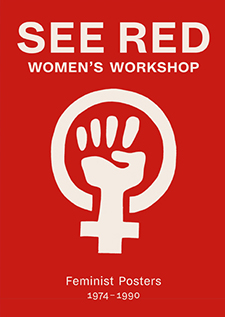
See Red Women’s Workshop Feminist Posters 1974–1990
Published by Four Corners Books
ISBN 978-1-909-82907-7
Released in September 2016, See Red Women’s Workshop Feminist Posters 1974–1990 collects sixteen years of posters, calendars, silkscreens, and more from the See Red Women’s Workshop. Founded in 1974, the group “grew out of a shared desire to combat sexist images of women and to create positive and challenging alternatives. With humor and bold graphics, they expressed the personal experiences of women as well as their role in wider struggles for change.” The 184-page book is written by See Red members and features the history of the group, including all of their original screenprints and posters commissioned for radical groups and campaigns.
“Ambitiously, See Red were not about selling a product or even getting over a party political message,” writes the British socialist feminist Sheila Rowbotham in the book’s foreword. “They were up to something far more complex and far more difficult. They aimed to convey ideas about a transformed society in which relations of gender, race and class would no longer be marked by inequality and subordination.”
Ambreen Butt: I Need a Hero
Isabella Stewart Gardner Museum
25 Evans Way, Boston, Massachusetts 02115
January 11–June 26, 2017
Ambreen Butt is the ninth artist in residence at the Isabella Stewart Gardner Museum, invited to create a temporary site-specific work for the museum’s façade. Throughout this project, Butt explores the ways in which women struggle to find and make use of their own power. Paying tribute to a fellow young Pakistani woman, I Need a Hero is inspired by the story of Mukhtar Mai, who was brutally raped in 2002 by order of her village tribal council as punishment for speaking out against archaic codes of justice. Refusing to be silenced, Mai not only became a spokesperson for women’s rights in Pakistan, but she also created two schools for girls and a crisis center for abused women.
In the Gardner façade piece, the heroine fights a dragon and a monkeylike creature (her inner and outer demons?). The wrestle is set against the background of a dollar bill as a reminder of today’s global economy, while other young women look at her from below and above, expectant on the results of the battle and a possible emergence of their hero(ine).
Butt was born in 1969, in Lahore, Pakistan, where she trained as a miniature painter. As a storyteller, the artist makes use of dramatic imagery from this traditional art form to comment on contemporary issues.
Tschabalala Self
Parasol unit foundation for contemporary art
14 Wharf Road,London N1 7RW
January 17–March 12, 2017
Parasol unit foundation for contemporary art presents the first solo exhibition in the United Kingdom by the New Haven–based artist Tschabalala Self. Curated by Ziba Ardalan, the exhibition brings together paintings, prints, collage, and sculptures drawn from the first five years of Self’s artistic career. The young artist (born New York, 1990) is concerned with the study of the black female body within contemporary culture. Self examines the confluence of race, gender, and sexuality through a variety of forms and narratives, in which each of her “characters,” as she calls them, explores the emotional, physical, and psychological impact of the black female body as icon.
Self’s paintings play boldly with figuration, deconstructing and reconstructing the black female body, sewing together pieces of African or African-inspired cloth, given to her by her mother, with fragments of unresolved pieces of work. Self’s fractured figure seems to assert its own self-defined identity, while mixed media allows her to explore how the black female body functions as a social and political symbol.
In addition to painting, collage, and sculpture, Self presents at Parasol unit her most recent animation work, My Black Ass (2016). Through a series of GIF portraits of abstractly drawn black female figures in a motion that suggests they are twerking, the black female character comes to life, displaying her buttocks and genitals in an energetic dance. Although based on a particular ethnicity, Self’s innovative works nonetheless speak universally of all humanity and its collective concerns.
Elena Dorfman: Syria’s Lost Generation
Mills College Art Museum
5000 MacArthur Blvd., Oakland, CA 94613
January 18–March 12, 2017
The Mills College Art Museum presents the Los Angeles–based artist Elena Dorfman’s Syria’s Lost Generation, a humanistic perspective to the ongoing Syrian conflict that has claimed more than 470,000 lives and forced the displacement of 6.5 million people.
Dorfman (born Boston, 1965) was on assignment with the United Nations High Commissioner for Refugees in 2013. While documenting exiled Syrians in Egypt, Jordan, Turkey, and Lebanon, she was drawn most strongly to Syrian teenagers, a small fraction of a population that has been disproportionately affected by the war. As Dorfman explains, “They seemed particularly shell-shocked and bereft…. [T]hey spoke to me of powerful longing and frustration.”
Dorfman has specialized in documenting extreme circumstances and unusual subjects. Syria’s Lost Generation builds on her previous work as a documentarian—in particular, The C-Word (1998), a series of photographs of teenagers living with cancer. Through visual and audio portraiture, Dorfman brings into exposure their voices, the physical and psychological ills suffered, their uncertain futures, and the fearful of retaliation. Displaced teenagers spoke about the powerful longing and frustration, where the dispossession seems absolute, and the future, lost.
Committee on Women in the Arts Picks January 2017
posted by CAA — January 16, 2017
Each month, CAA’s Committee on Women in the Arts selects the best in feminist art and scholarship. The following exhibitions and events should not be missed. Check the archive of CWA Picks at the bottom of the page, as several museum and gallery shows listed in previous months may still be on view or touring.
January 2017
The Future is Female
21c Museum Hotel
700 West Main Street, Louisville, Kentucky
November 2016–May 2017
The Future is Female at the Louisville, KY, 21c Museum Hotel, features feminist art from the 21c collection, including painting, video, photography, and installation. Works on view include pieces by Carrie Mae Weems, Jenny Holzer, Nandipha Mntambo, Kiki Smith, and Frances Goodman, among many others. “Gleaming acrylic fingernails glued into patterned, reptilian forms that emerge from the wall; barnacles and ceramic teeth encrusted in life-size human figures in decay; cement seeping through lace and paint; haunting words about the present overlaid on imagery of the past: surface tension abounds in this exploration of contemporary feminist art.”
Curated by Alice Gray Stites, chief curator and museum director, the exhibition fuses celebration and critique through engaging and evocative art. In Alison Saar’s work on view, Hades D.W.P., five glass jars are filled with water to varying levels. Each jar is “tagged with lines of poetry, their surfaces etched with figures that float between life and death.” While the work hints the water is meant for drinking, its toxic colors indicate otherwise, alluding to the drinking water disaster in Flint, Michigan.

Pat Oleszko: Fool for Thought
Women’s Studies Research Center/Kniznick Gallery
Brandeis University, Epstein Building, 515 South Street, Waltham, MA
November 21, 2016–March 3, 2017
The visual and performance artist Pat Oleszko brings her signature style to the Kniznick Gallery, which presents an exhibition of her costumes, inflatables, videos, and props. “With elaborate handmade costumes and props, Oleszko utilizes the body as armature for ideas in an array of lampoons that call her audience to action.” Through humor and the absurd, Oleszko touches on issues from the personal to the political. Fool for Thought highlights her performances, including Hello Folly: The Floes & Cons of Arctic Drilling, Oldiloks and the Bewares, Stalking Walking Topiary, and the Pat and the Hats. Self-identified as the Fool in question and the questioning Fool, Oleszko fans the flames with rousing absurdity and maintains that she who laughs, lasts.
The exhibition also includes several events, including an artist’s lecture with Oleszko and a reception on January 25 and a lecture on February 2 with Barbara Bodenhorn. The lecture will focus on the combination of art and science as it seeks to engage young people in ecologically vulnerable regions.
A Woman’s Afterlife: Gender Transformation in Ancient Egypt
tBrooklyn Museum
200 Eastern Parkway, Brooklyn, New York
Starting December 15, 2016
Through new research and scholarship, the Egyptian artifacts in A Woman’s Afterlife explore the gender transformation of deceased women and the difference between male and female access to the afterlife. The exhibition is part of A Year of Yes: Reimagining Feminism at the Brooklyn Museum, a yearlong project celebrating a decade of feminist thinking at the institution.
“Egyptian medicine taught that a woman, once in her tomb, faced a biological barrier to rebirth. Because the ancient Egyptians believed that in human reproduction it was the man who created the fetus, transferring it to the woman during intercourse, rebirth was impossible for a woman alone.” It was the priest’s role to magically transform the woman’s mummy into a man, thus creating a fetus. This was accomplished through incanted spells with masculine pronouns, graphic representations of those spells on the coffin, and adding red skin—a color assigned to men. The centerpiece, a painted coffin and mask of Weretwahset, exemplifies these steps and depicts her fleeting transformation from female to male.
The exhibition was sparked by researched published by the scholars Kathlyn M. Cooney (University of California, Los Angeles), Heather McCarthy (New York University), Gay Robins (Emory University), and Ann Macy Roth (New York University). “This research has led to a better understanding of the logic behind this unexpected gender transformation by discovering that women were intentionally represented with red skin and with masculine pronouns. Previously, these representations were regarded as mere mistakes,” said Edward Bleiberg, curator of Egyptian art. “Feminism has changed the questions we ask of ancient history as well as the answers we offer. This is a striking example of how feminism has provided a basis for new scholarship that reinterprets an ancient puzzle.”
Catalina Schliebener: Growing Sideways
Bureau of General Services—Queer Division
208 West 13th Street, Room 210, New York
Open until January 22, 2017
The Bureau of General Services Queer Division presents Growing Sideways, an exhibition of new work by the Buenos Aires–based Chilean artist Catalina Schliebener (b. Santiago, 1980). Organized by the independent curator John Chaich, the exhibition takes its title—and somewhat its conceptual and formal inspiration—from the queer scholar Kathryn Stockton Bond’s notion that rather than the normative view of “growing up,” the nonstraight child grows sideways through life-long, lateral interactions between childhood motivations and adult identifications, formed by sly intentions, blurred chronologies, and animalistic attachments.
Growing Sideways presents over five dozen drawings on collage that frame the space and culminate in a floor-to-ceiling mural, growing across two- and three-dimensional surfaces and creating a disjointed narrative exploring gender formation and erotic curiosity through Schiebener’s combination of cuttings from found children’s books with abstract drawings and vinyl mural recalling organic sensual shapes in nature and the body. An artist-curated selection of books accompanies the site-specific installation.
A dialogue with the artist, Chaich, and Kris Grey will take place on January 12, 2017, at 7:00 PM.
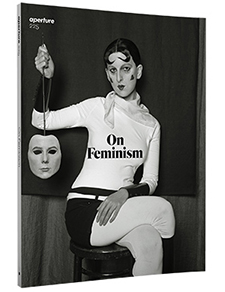
On Feminism
Aperture #225 (Winter 2016)
Aperture’s winter issue has focused “On Feminism.” In a moment that the very idea of gender is central to local and global conversations about equality, this approach arrives at a right moment to address the power and influence that women hold on the stage of the art world and beyond.
This issue focuses on intergenerational dialogues, debates, and strategies of feminism in photography, acknowledging the immense contributions by artists whose work articulates or interrogates representations of women in media and society. “On Feminism” features include a lively roundtable with curators from Paris and New York on modernist photographers between the wars, Nancy Princenthal on the feminist avant-garde of the 1970s, Eva Díaz on protest and visual politics, Laura Guy on lesbian erotica as critical rebellion, Eva Respini on abstraction, Julia Bryan-Wilson on visions of trans feminism, and a conversation with Renée Cox about black feminist icons, plus contributions from Martha Rosler and Maria Nicolacopoulou, among others, as well as portfolios by Farah Al Qasimi, Jennifer Blessing, Zackary Drucker, Catherine Morris, A. L. Steiner, Zanele Muholi, Yurie Nagashima, Elle Pérez, Laurie Simmons, Cosey Fanni Tutti, and Gillian Wearing.
The issue’s contents are organized in two main sections that underscores how photography has shaped feminism as much as how feminism has shaped photography. Use #OnFeminism to join the conversation on Twitter, Instagram, and Facebook.
Nairy Baghramian: Déformation Professionnelle
S.M.A.K.
Jan Hoetplein 1, 9000 Ghent, Belgium
November 26, 2016–February 19, 2017
S.M.A.K. presents Déformation Professionnelle, a solo exhibition by influential Iranian sculptor Nairy Baghramian. Born in 1971 in Isfahan, Iran, Baghramian is currently living and working in Berlin. She has become internationally known for her contextual approach to exhibition-making via sculpture and photography. Focusing in a site-responsive practice, her works explore the body and its supportive functions.
Déformation Professionnelle is a new production which builds on eighteen works in the artist’s oeuvre from 1999 to 2016. Baghramian alludes to existing work from discarded ideas to working material. In the artist’ words, she is “surveying the survey.” This body of work formulates fundamental questions about progress and economy, while interrogating what happens when something ceases to exist, and how something new comes into being.
The exhibition includes several large-scale works such as Class Reunion (2008), Retainer (2012), and French Curve (2014). Both inside and outside the museum,the display evidences the artist complex engagement with the transformation and consequent deformation of form, language, and meaning in its translation from one series into the other.
Nairy Baghramian | Déformation Professionnelle is organized by S.M.A.K. and the Walker Art Center in Minneapolis, where the exhibition will travel in October 2017.



